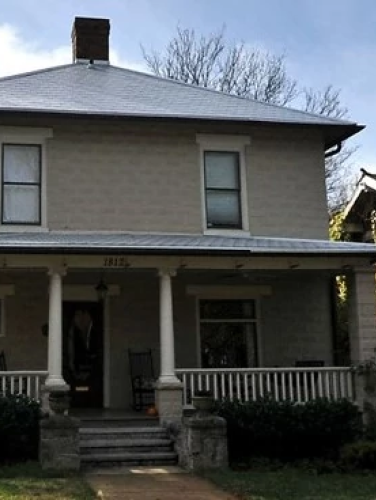
Ziem House
(ca. 1910)
The concrete block Harry Arthur Ziem House was the handiwork of one of Charlotte’s most notable innovators in concrete block construction in the early 1900s.
1812 E 8th St, Charlotte, NC 28204
The Harry Arthur Ziem House in Elizabeth is likely the only remaining structure in Charlotte built by James C. Herring (c. 1852-1921), a local innovator in concrete block construction in the early 1900s. In November 1909, Ziem contracted Herring to build an eight-room concrete block house on 8th Street Extension in Elizabeth Heights. Perfected in the late 1800s and achieving its greatest popularity during the first decade of the twentieth century, concrete block was one of the most important building materials developed in the nineteenth century, as it was fireproof, inexpensive to produce, and capable of assuming a variety of cut-stone-like surfaces through the use of molds.
Property Quick Links
A native of Pender County, North Carolina, Herring worked as a brick manufacturer and builder in Wilmington before moving to Charlotte in 1889 to launch his new general contracting business, constructing numerous frame and brick residences and other buildings. His work in concrete block manufacture and construction was part of a trend sweeping the country following the 1887 issuance of a U.S. patent to Harmon S. Palmer for a machine for molding brick blocks. Palmer’s concrete block machine inspired a multitude of imitators across the country, including Herring who expanded his business to artificial stone manufacture in 1902 with the purchase of Statesville’s Holder Brothers tilling plant. He relocated the business to Charlotte as the Herring Artificial Stone Company on East 8th Street at railroad, where he manufactured a variety of cement, building block, and paving block products. In 1907, Herring secured his own patent for an easily adjustable machine capable of manufacturing bricks and blocks of different sizes from concrete or plastic, in hopes that such blocks would become Charlotte’s standard building material of choice. They did not, even though by 1910, he had provided blocks for at least ten large residences across Charlotte, including for an apartment building at the corner of Mint and Hill Streets for Thomas J. Hawkins, who later served as mayor of Charlotte. Despite his marketing efforts, Herring found concrete paving products to be a more profitable venture, prompting him to return to Wilmington to purchase and operate a lime and brick plant.
It is unclear when Chicago native Harry Ziem (1865-1941) relocated to Charlotte, but records show he purchased the East 8th Street lot in Elizabeth Heights from the Highland Park Company in July 1909 for $550. His house was likely completed in 1910. According to former neighbors, Ziem designed the house. In the early 1910s, both Harry and his wife Nancy (1877-1962) worked for the Hamilton Millinery Company on South Tryon Street, he as a traveling salesman, and she as a milliner. Starting in 1914, Harry spent most of his working years as a decorative painter of signs, automobiles and ornamental designs, while Nancy remained a milliner for many years. After Harry Ziem’s death in 1941, Nancy lived in the house until she passed away in 1962. The house has since changed hands several times until, in 1979, the then-owner undertook extensive restoration efforts to help preserve this unusual house as part of Charlotte's unique turn-of-the-century streetcar suburb heritage.

